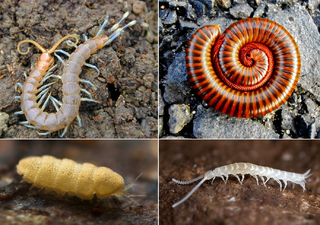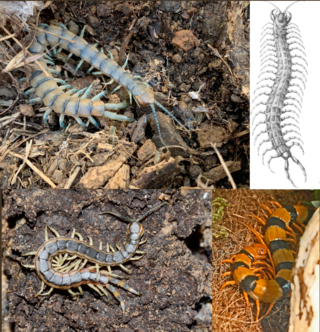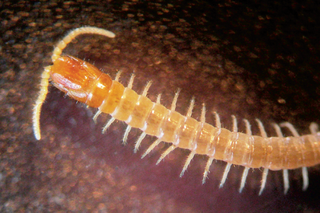
Centipedes are predatory arthropods belonging to the class Chilopoda of the subphylum Myriapoda, an arthropod group which includes millipedes and other multi-legged animals. Centipedes are elongated segmented (metameric) creatures with one pair of legs per body segment. All centipedes are venomous and can inflict painful stings, injecting their venom through pincer-like appendages known as forcipules or toxicognaths, which are actually modified legs instead of fangs. Despite the name, no centipede has exactly 100 pairs of legs; number of legs ranges from 15 pairs to 191 pairs, always an odd number.

Myriapods are the members of subphylum Myriapoda, containing arthropods such as millipedes and centipedes. The group contains about 13,000 species, all of them terrestrial.

Scolopendridae is a family of large centipedes.

Scolopendra is a species-rich genus of large tropical centipedes of the family Scolopendridae.

The Scolopendromorpha, also known as tropical centipedes and bark centipedes, are an order of centipedes whose members are epimorphic and usually possess 21 or 23 trunk segments with the same number of paired legs. The number of leg pairs is fixed at 21 for most species in this order and fixed at 23 for the remaining species, except for two species with intraspecific variation: Scolopendropsis bahiensis, which has 21 or 23 leg pairs, and Scolopendropsis duplicata, which has 39 or 43 leg pairs. Species in this order have antennae with 17 or more segments. The order comprises the five families Cryptopidae, Scolopendridae, Mimopidae, Scolopocryptopidae, and Plutoniumidae. Nearly all species in the family Scolopendridae have four ocelli on each side of the head, and the genus Mimops features a pale area often considered an ocellus on each side of the head, whereas the other three families are blind. Species in the family Scolopocryptopidae have 23 leg-bearing segments, whereas species in all other families in this order have only 21 leg-bearing segments. The only 3 known amphibious centipedes, Scolopendra cataracta, Scolopendra paradoxa and Scolopendra alcyona belong to this order.

Scutigeridae is a family of centipedes that are known as house centipedes. It includes most of the species of house centipedes, including Scutigera coleoptrata and Allothereua maculata.

Scolopocryptopidae is a family of blind centipedes. The number of leg-bearing segments is fixed at 23 for species in this family, which distinguishes the species in this family from all other centipede species.

Himantariidae is a monophyletic family of centipedes in the order Geophilomorpha and superfamily Himantarioidea, found almost exclusively in the Northern Hemisphere. Centipedes in this family feature a short head with a concave labral margin bearing a row of denticles, a single dentate lamella and some pectinate lamellae on each mandible, second maxillae with strongly tapering telopodites and slightly spatulate claws, and a stout forcipular segment with short forcipules and a wide tergite; the ultimate legs usually have no pretarsus, and the female gonopods are distinct and biarticulate.
Dendrothereua is a genus of house centipedes in the family Scutigeridae. There are at least three described species in Dendrothereua, found in the southern United States and the Neotropics.

Mecistocephalidae is a monophyletic family of centipedes in the order Geophilomorpha. It is the only family in the suborder Placodesmata. Most species in this family live in tropical or subtropical regions, but some occur in temperate regions. This family is the third most diverse in the order Geophiliomorpha, with about 170 species, including about 130 species in the genus Mecistocephalus.

Geophilus is a large, heterogeneous genus of soil centipedes in the family Geophilidae largely considered to be synonymous with Brachygeophilus. This genus is a mostly holarctic and characterized by a claw-shaped ultimate pretarsus, anterior porefields, complete or nearly complete coxo-pleural sutures at the prosternum, and incomplete chitin-lines. Centipedes in this genus feature slightly elongate heads and labral intermediate parts with tubercles, the forcipules are usually poorly elongate with a single small tubercle at the base of each tarsungulum, and the anterior trunk metasternites usually have an anterior medial socket and a posterior transversally elongate pore-field. The generic name first appeared in Brewster's Edinburgh Encyclopaedia in 1814 as Geophilus electricus.

Schendylidae is a family of centipedes in the order Geophilomorpha.

Strigamia is a genus of soil centipedes in the family Linotaeniidae. Members of this family can be identified by their anteriorly tapering bodies, the extra claw on the forcipules, scattered coxal pores, and the distinctly swollen ultimate legs of the males. There are at least 50 described species in Strigamia. Centipedes in this genus can reach 15 cm in length and can have as few as 31 pairs of legs or as many as 83 leg pairs. The species S. hoffmani is notable for its small size as well as for a small number of legs. Other species with notably few legs include the Siberian species S. sibirica and the Romanian species S. lutea.

Hemiscolopendra is a genus of bark centipedes in the family Scolopendridae. There are about six described species in Hemiscolopendra, found in North, Central, and South America.

Tygarrup is a genus of centipedes in the family Mecistocephalidae, found mainly in southeast Asia and from the Seychelles to Hawaii. Although species in this genus can have either 43 or 45 leg-bearing segments, most of these species have 45 leg pairs. An undescribed Tygarrup species found in the Andaman Islands has 43 leg pairs. Centipedes in this genus are sometimes melanised in patches, and sternal glands are present the males of most species. These centipedes range from 2 cm to 6 cm in length. Tygarrup javanicus is one of the smallest of the mecistocephalid species and has become an invasive in greenhouses in Europe.
Arrup is a genus of centipedes in the family Mecistocephalidae, native to Europe and Asia as far as Japan. Centipedes in this genus feature small telopodites on the second maxillae, the head and forcipular segment are elongate, the clypeus is almost completely areolate, and the poison glands in adult males are often deep inside the forcipules. These centipedes range from 1 cm to 5 cm in length. All species in this genus have 41 leg-bearing segments. Most are soil-dwellers but Arrup akiyoshiensis is a troglobiont.
Anarrup is a genus of centipedes in the family Mecistocephalidae, native to Europe and Asia as far as Indonesia. Centipedes in this genus feature a clypeus with areolation and setae limited to a short anterior marginal band; the second maxillae have swollen and densely setose telopodites and a coxosternite divided mid-longitudinally. These centipedes range from 6 cm to 8 cm in length. All species in this genus have 41 leg-bearing segments.

Ballophilidae is a monophyletic group of centipedes belonging to the order Geophilomorpha and superfamily Himantarioidea. Authorities now dismiss this group as a family, citing phylogenetic analysis, and instead refer to this clade as Ballophilinae, a possible subfamily within the family Schendylidae. Centipedes in this clade differ from others in the family Schendylidae by having bodies tapered toward the anterior tip, short heads, slender forcipules that are well apart, and an undivided lamina for the female gonopods.
Mecistocephalus is a genus of centipedes in the family Mecistocephalidae. It was described by British entomologist George Newport in 1843.
Gonibregmatus is a genus of centipedes in the family Gonibregmatidae. It was described by British entomologist George Newport in 1843.
















